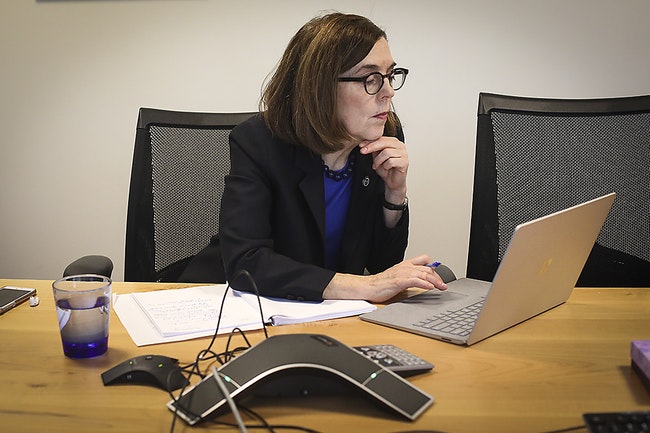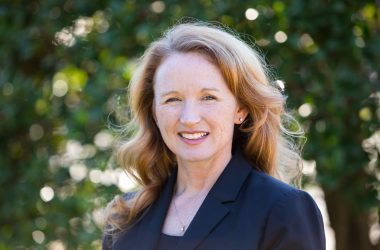
Gov. Kate Brown (Amanda Loman/Salem Reporter)
[ NOTE: Salem Reporter is providing this information free as a community service. You can support dissemination by subscribing. ]
ONTARIO – The unrelenting spread of the coronavirus in Malheur County prompted Gov. Kate Brown on Thursday to move the community back a level in its reopening efforts, a decision that won’t change life for most residents.
But the Vale swimming pool and Ontario’s splash pad will have to close by Monday. Other impacts weren’t immediately clear.
Brown announced the pullback to Phase I as cases of Covid locally continue to climb and the county’s cumulative positive testing rate hovers at 19%.
“Over the past month, COVID-19 cases in Malheur County have risen so much that restrictions must be put back in place or we risk further illnesses and death in the region,” said Brown. “I know this change is difficult, but immediate action is necessary in order to reduce the spread of the disease and protect all those who call Malheur County home.”
As of Thursday, the county reported 847 Covid cases and a weekly positive testing rate of 25%.
In her announcement, Brown cited other statistics from Malheur County that caused her to act:
*The county has the third highest case rate in Oregon – 266 cases per 10,000 people. Umatilla are higher.
*The county has reported an average of 15 new cases a day for the past two weeks.
*The rate of positive tests has been 26% the past two weeks – nearly five times the state average of 5.8%.
In late July, the governor moved Morrow County, home of the the bustling industrial port town of Boradman, to Phase 1 and at the same time moved Umatilla even farther back, to a baseline level that stopped sit-down dining and ended personal care services.
But in Malheur County, the drop into Phase I will be more of a psychological adjustment.
That’s because the county was already in a modified version of the Phase II reopening after a decision by the Malheur County Court in July and the governor’s earlier orders.
Restaurants and bars would have to shut down at 10 p.m. in Phase 1 – but the governor already ordered such closures statewide.
The state’s rules for gatherings are tighter in Phase 1, with social get-togethers limited to 10 people, and cultural, civic and faith gatherings limited to 50 for indoors or outdoors.
But under modified measures approved by the Malheur County Court on July 15, no groups of 25 or more could gather outdoors, and groups of less than 10 indoors and less than 25 outdoors must wear face coverings, follow social distancing guidelines and keep 6 feet apart.
On July 22, Gov. Brown lowered gatherings size limits for indoor venues – larger restaurants, bars, community centers, churches, movie theaters and gyms – to 100 people indoors, and 250 people for outdoor venues.
The Malheur County Health Department announced the county’s first positive Covid test on March 29.
The county was approved to enter Phase 2 on June 4, and the health department reported the first death attributed to Covid two days later.
Brown announced July 3 that Malheur County was put on a state “Watch List” after its total cases doubled in less than a week, warning that new restrictions could come if there wasn’t a quick downturn. Before it shifted to Phase 1, Malheur County was one of nine Oregon counties on the list.
The White House placed Malheur County and Ontario in a Covid “red zone” and recommended stricter guidelines, including bar and gym closures, according to a state report dated July 14.
The latest move to combat the Covid outbreak may not be the last, said Sarah Poe, Malheur County Health Department director.
“Unless our numbers improve we can expect to see more restrictions,” said Poe.
State Rep. Mark Owens, R-Crane, said the governor’s announcement Thursday was a surprise “because Malheur County numbers had stabilized and I think the local public health had done a great job,” said Owens.
Owens said Malheur County is in a “tough spot” because of its proximity to Idaho.
Cases of the virus, he said, are “leaking over” into the county.
“The plain truth is we need to figure out how to slow the spread of COVID-19. We need to make sure we have more testing capabilities,” said Owens.
Poe said the realignment to Phase I will help the county but isn’t a final solution.
“We need to recognize the virus doesn’t recognize boundaries. As much as we can address our case numbers we need to address case numbers as a whole and recognize it is coming from multiple counties,” said Poe.
Poe said the action by the governor was based on the fact “our numbers surged and they didn’t go down.”
SUPPORT ESSENTIAL REPORTING FOR SALEM – A subscription starts at $5 a month for around-the-clock access to stories and email alerts sent directly to you. Your support matters. Go HERE.









